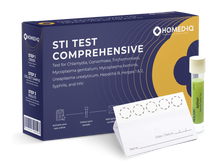Lauren is a health scientist and science communicator currently living in the Netherlands. Originally from Canada, she completed a Research Master’s in Health Sciences at the Netherlands Institute of Health Sciences at Erasmus University Rotterdam (NIHES) with a specialisation in epidemiology. Prior to her master’s degree, she completed a Bachelor’s degree in Health Sciences at Simon Fraser University. With a background in public health, her goal is to create accurate scientific content that is easy to understand and empowers people to make informed decisions. Within Homed-IQ, Lauren works as a Product Developer and Content Lead, working closely with physicians and scientists on medical devices for Homed-IQ’s new products and written communications.
What is HDL cholesterol? Levels and significance
HDL stands for high-density lipoprotein, a type of cholesterol found in our blood. It is essential for our heart health and is often referred to as “good cholesterol.” But why is it considered “good,” and why is it so important for our health? Read on to get all the valuable information.
Table of Contents
- What does HDL mean?
- Why is HDL cholesterol important?
- What is a healthy HDL level?
- What are the causes of high or low HDL levels?
- How can I test my HDL level?
- What should you do if your HDL cholesterol is too low?
- Summary
What does HDL mean?
Cholesterol comes in different types, classified according to the proteins that transport it through the bloodstream, called lipoproteins. The two primary kinds are high-density lipoprotein (HDL) and low-density lipoprotein (LDL):
- HDL is often referred to as the “good” cholesterol because it helps clear cholesterol from the arteries by transporting it back to the liver, where it can be broken down and eliminated.
- LDL is known as the “bad” cholesterol since it tends to deposit cholesterol in the arteries, which can contribute to blockages.
Source: Healthdirect Australia, 2025
Why is HDL cholesterol important?
HDL cholesterol acts like a cleanup system for your bloodstream. It helps to:
-
Remove excess cholesterol from artery walls
-
Transport cholesterol to the liver for disposal
-
Reduce the risk of blocked arteries and cardiovascular events
-
Offset some of the negative effects of LDL (“bad”) cholesterol
While having high HDL levels is generally considered a good thing, very high levels (especially above 2.5 mmol/L or 100 mg/dL) may also be associated with certain health risks (such as increased risk of heart disease); particularly in people with other underlying conditions such as chronic inflammation or hypertension. Always consult with a healthcare provider when interpreting your results.
Source: CDC, n.d.; Mayo Clinic, 2024
What is a healthy HDL level?
Here are the normal and abnormal HDL cholesterol ranges for adults, which vary by sex:
| Group | Low HDL | Normal HDL | High HDL |
|---|---|---|---|
| Adult Males | Below 40 mg/dL | 40 to 80 mg/dL | Above 80 mg/dL |
| Adult Females | Below 50 mg/dL | 50 to 80 mg/dL | Above 80 mg/dL |
| Children/Teens | — | 45 to 80 mg/dL | Above 80 mg/dL |
Source: Cleveland Clinic, 2025
What are the causes of high or low HDL levels?
A low HDL level can have various causes:
-
Metabolic syndrome: A cluster of risk factors for heart disease, including low HDL.
-
BMI over 25 (Excess weight or obesity)
-
Smoking or tobacco use
-
ApoA1 deficiency: A genetic condition where the body lacks enough Apolipoprotein A1, an essential HDL component.
-
Tangier disease: A rare genetic disorder that causes very low HDL.
-
Certain medications: Beta-blockers, hormones, and some diuretics may temporarily lower HDL, but stopping them without medical advice increases heart disease risk.
-
Insulin resistance: when the body’s cells don’t respond well to insulin, making it harder to control blood sugar and often leading to lower HDL cholesterol
-
Familial combined hyperlipidemia: a genetic condition that causes abnormal cholesterol levels, with HDL too low and LDL too high
A high HDL level can have various causes:
-
Alcohol use disorder
-
Hyperthyroidism: a condition where the thyroid gland makes too much thyroid hormone, speeding up the body’s processes
-
Primary biliary cholangitis: a long-term liver disease where the small bile ducts inside the liver become damaged, leading to liver problems
-
Gene changes: alterations in DNA that can affect how the body works or increase the risk of certain diseases
-
Side effects from medications
Source: Cleveland Clinic, 2022
It is important to talk to your doctor about the causes of your HDL level and determine whether treatment is necessary.
How can I test my HDL level?
With the Homed-IQ Cholesterol and Lipids Test, you can measure your HDL level from home. You will also measure your LDL and total cholesterol levels. The test is conducted through a simple finger prick. A certified laboratory then analyzes your blood sample, and you can view the result within a few days.
How often should I test HDL?
There is no fixed recommendation for the frequency of HDL tests.
-
General testing: Every 5 years from age 45.
-
High-risk groups: Every 12 months if you have high blood pressure, diabetes, heart disease, stroke, kidney disease, or familial hypercholesterolaemia (a genetic condition causing high cholesterol).
Source: Healthdirect Australia, 2025
You can check your HDL level at any time using a home test. For most adults, cholesterol levels remain relatively stable over time. Nonetheless, changes in lifestyle or diet may warrant a recheck of your HDL levels.
What should you do if your HDL cholesterol is too low?
Improving your HDL levels naturally can help protect your cardiovascular system. Consider the following strategies:
-
Exercise regularly: Aim for at least 150 minutes of moderate aerobic activity per week
-
Quit smoking: This can quickly increase HDL levels
-
Eat healthy fats: Focus on monounsaturated fats (olive oil, avocados) and omega-3s (fatty fish, flaxseed)
-
Maintain a healthy weight: Even small weight loss can improve HDL
-
Limit refined sugars and trans fats
-
Drink alcohol only in moderation (if at all)
There are no medications that directly target HDL levels, so lifestyle changes remain the most effective way to improve them.
Source: Stichting Voedingscentrum Nederland, n.d.; Mayo Clinic, 2022.
Summary
HDL cholesterol is essential for maintaining a healthy cardiovascular system. It helps remove excess cholesterol from the bloodstream and can reduce your risk of heart disease. While higher levels are generally beneficial, balance is key. Low HDL levels can increase your risk of health complications—but with the right lifestyle changes and regular monitoring, you can take control of your heart health.









